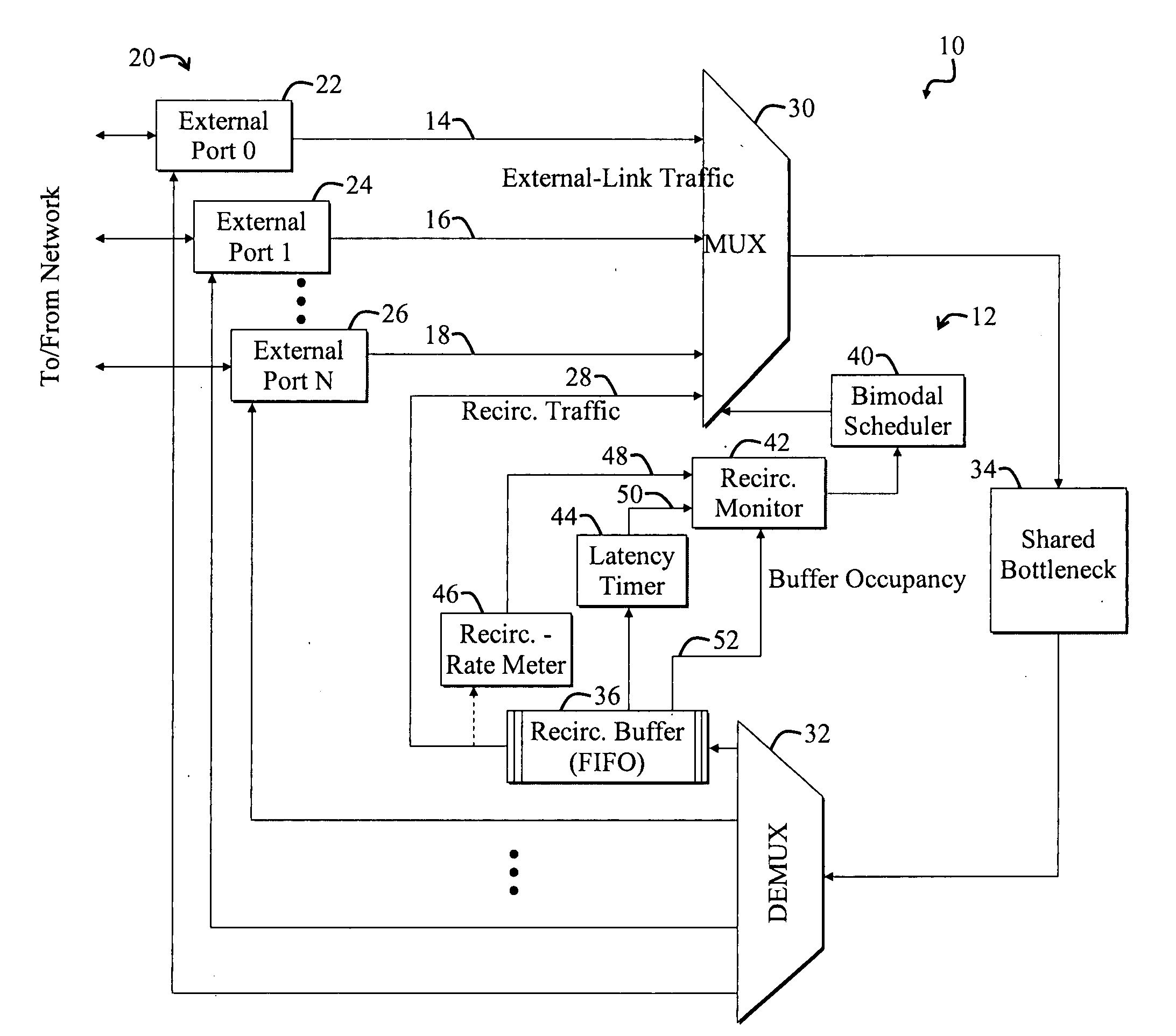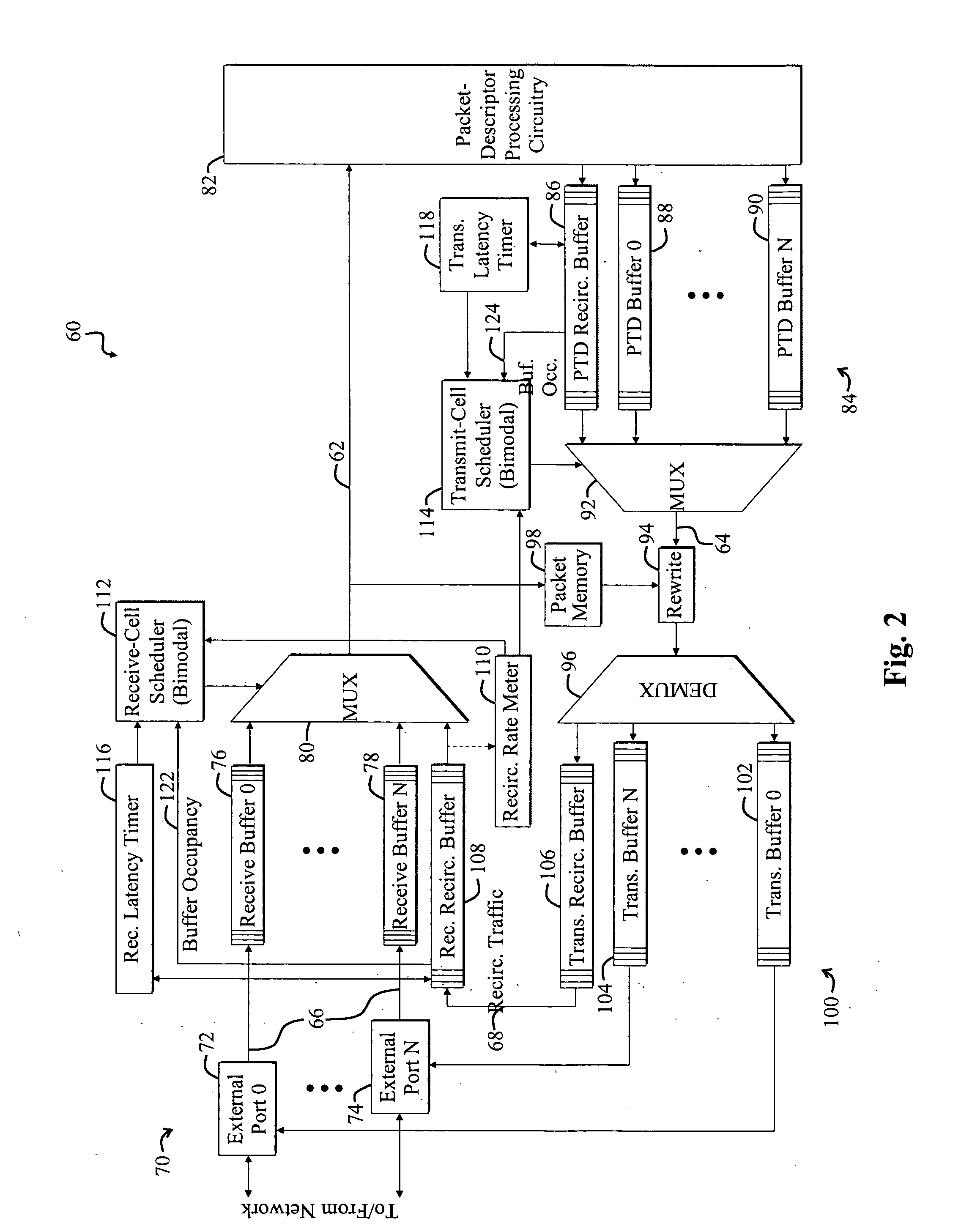System and method for managing bandwidth
a bandwidth management and bandwidth technology, applied in the field of networks, can solve the problems of large memory buffers, oversubscription of switches or routers, and packet recirculations consuming the bandwidth required of switches,
- Summary
- Abstract
- Description
- Claims
- Application Information
AI Technical Summary
Problems solved by technology
Method used
Image
Examples
first embodiment
[0019]FIG. 1 is a diagram of a switch 10 employing a system 12 for selectively scheduling external-link traffic 14, 16, 18 and recirculation traffic 28 according to the present invention. The switch 10 includes various external ports 20, including a zeroth external port 22, a first external port 24, and an Nth external port 26, which send and receive external-link traffic to and from an outside network (not shown). For the purposes of the present discussion, external-link traffic may be any traffic sent between a network device, such as the switch 10, and an entity that is external to the network device.
[0020]A switch may be employed to affect how traffic flows over a network. Examples of switches include Layer-2 (L2), Layer-3 (L3), and multilayer switches and routers. These devices are named in accordance with the Open Systems Interconnection (OSI) layer associated with the devices' operations. For example, an L2 switch performs various OSI-layer-2 (data layer) functions, such as d...
second embodiment
[0052]FIG. 2 is a diagram of a switch 60 with plural traffic bottlenecks, including a receive-path bottleneck 62 and a transmit-path bottleneck 64. The switch 60 is adapted to selectively schedule external-link traffic 66 and recirculation traffic 68 according to the present invention. The switch 60 includes plural external ports 70 for handling external-link traffic 66, including a zeroth port 72 and an Nth port 74. A corresponding zeroth receive buffer 76 is connected between an output of the zeroth port 72 and an input of a receive-path multiplexer 80. Similarly, an Nth receive buffer 78 is connected between an output of the Nth port 74 and an input of the receive-path multiplexer 80.
[0053]An output of the receive-path multiplexer 80 is input to packet-descriptor processing circuitry 82, outputs of which are connected to inputs of plural Packet Transmit Descriptor (PTD) buffers 84. The PTD buffers 84 include a PTD recirculation buffer 86, a zeroth PTD external-link buffer 88, and...
third embodiment
[0078]FIG. 4 is a diagram of a system 150 for selectively scheduling traffic from first types of ports 152-156 and second types of ports 158-160 to pass through shared resources according to the present invention. The system 150 includes a central MUX 162 that receives type-one traffic 164-168 from the first types of ports 152-156, respectively. The central MUX 162 receives type-two traffic 170, 172 from buffers 174, 176 that buffer the type-two traffic 170, 172 at the outputs of the second types of ports 158-160.
[0079]The scheduling system 150 includes MUX-control circuitry 180 that includes a type-two service-rate meter 182, and a type-two latency timer 184, which provide service-rate information 186 and latency information 188, corresponding to the type-two traffic 170, 172, to a type-two service monitor 190. The type-two service monitor 190 also receives type-two buffer-occupancy information 192 directly from the buffers 174, 176.
[0080]In operation, the type-two service monitor ...
PUM
 Login to View More
Login to View More Abstract
Description
Claims
Application Information
 Login to View More
Login to View More - R&D
- Intellectual Property
- Life Sciences
- Materials
- Tech Scout
- Unparalleled Data Quality
- Higher Quality Content
- 60% Fewer Hallucinations
Browse by: Latest US Patents, China's latest patents, Technical Efficacy Thesaurus, Application Domain, Technology Topic, Popular Technical Reports.
© 2025 PatSnap. All rights reserved.Legal|Privacy policy|Modern Slavery Act Transparency Statement|Sitemap|About US| Contact US: help@patsnap.com



